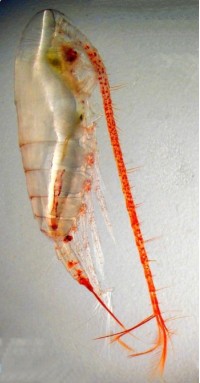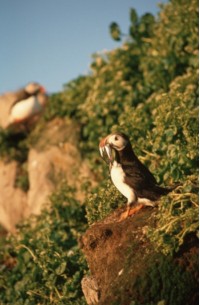Primary and secondary consumers – the middle-management level
 Calanus finmarchicus, a copepod which lives mainly in arctic waters. Calanus finmarchicus is highly nutritious for seabirds. It feeds on phytoplankton and converts this food into energy-rich oil which it stores in an internal oil sack. This oil is a veritable food concentrate for other creatures.
Illustration: Eva Leu, NPI
There are two middle-management levels in Arctic Ltd. The lowest is the primary consumers, which are organisms that live on plants. The level above comprises the secondary consumers, animals which eat animals that eat plants.
Calanus finmarchicus, a copepod which lives mainly in arctic waters. Calanus finmarchicus is highly nutritious for seabirds. It feeds on phytoplankton and converts this food into energy-rich oil which it stores in an internal oil sack. This oil is a veritable food concentrate for other creatures.
Illustration: Eva Leu, NPI
There are two middle-management levels in Arctic Ltd. The lowest is the primary consumers, which are organisms that live on plants. The level above comprises the secondary consumers, animals which eat animals that eat plants.
The Svalbard reindeer, the Svalbard ptarmigan and the sibling vole are the only terrestrial creatures that remain in Svalbard all winter and are herbivorous, but when the hordes of migrant geese return in spring they sometimes close crop entire areas of wetland to satisfy their need for plant food. Alongside reindeer grazing, this is the grazing activity that exerts most pressure on the land vegetation in Svalbard.
In the sea, zooplankton consume the phytoplankton. They reproduce in spring, at the same time as the phytoplankton blooms are at their peak making the maximum amount of food available. Since the edge of the sea ice is a productive zone for the phytoplankton, the same applies to the zooplankton, and as the ice gradually retreats northwards through the summer, the zooplankton production follows it.
Many other species exploit this enormous supply of food and the ice edge in summer abounds in animal and bird life. The zooplankton are voraciously devoured by numerous larger species, mainly other zooplankton, fish and shrimps, but also some birds. For instance, the main food of the polar cod is zooplankton and other small fish, but it is itself eaten by larger fish and seabirds, and, along with the capelin, it is the main item on the diet of larger species of fish, seabirds, whales and seals.
As most creatures find their food at different levels in the food pyramid, it is difficult to rank them in order in chains, and we therefore speak of a food web. For instance, the Arctic fox and the glaucous gull find their food at many different levels in the food pyramid. They are generalists and eat practically everything they come across, even rubbish.
 A puffin near its nest in eastern Finnmark, with its beak full of small fish. The nutrients that make the slopes below the bird cliffs exceptionally green originate in the sea. The birds take food from the sea to their nests. Their excrements are excellent fertiliser for plants in the Arctic, which otherwise grow on particularly poor soils. The puffin is a typical colonial breeder which excavates its nest in grass-covered earth on islands and islets. Where earth is absent, it nests in fissures and cavities in cliffs, or among stones. Most of the Svalbard colonies consist of more or less scattered pairs on steep cliffs where they nest along with fulmars, kittiwakes and Brünnich's guillemots. Puffins mostly eat small, shoaling fish. Outside the breeding season, they live almost exclusively on the open sea and obtain all their food there.
Illustration: Geir Wing Gabrielsen, NPI
Animals that have specialised on just one species as their food are called specialists, but because particular food may be periodically very difficult to come by in the Arctic, it is good to have alternative sources to turn to. Consequently, there are not many pure specialists. However, a few species on the middle-management level can almost be called specialists because they very much prefer one particular item of food where it is available.
A puffin near its nest in eastern Finnmark, with its beak full of small fish. The nutrients that make the slopes below the bird cliffs exceptionally green originate in the sea. The birds take food from the sea to their nests. Their excrements are excellent fertiliser for plants in the Arctic, which otherwise grow on particularly poor soils. The puffin is a typical colonial breeder which excavates its nest in grass-covered earth on islands and islets. Where earth is absent, it nests in fissures and cavities in cliffs, or among stones. Most of the Svalbard colonies consist of more or less scattered pairs on steep cliffs where they nest along with fulmars, kittiwakes and Brünnich's guillemots. Puffins mostly eat small, shoaling fish. Outside the breeding season, they live almost exclusively on the open sea and obtain all their food there.
Illustration: Geir Wing Gabrielsen, NPI
Animals that have specialised on just one species as their food are called specialists, but because particular food may be periodically very difficult to come by in the Arctic, it is good to have alternative sources to turn to. Consequently, there are not many pure specialists. However, a few species on the middle-management level can almost be called specialists because they very much prefer one particular item of food where it is available.
As all forms of life are closely tied to one another through the food chain, a collapse in one link may have a strong impact on the links above. The common guillemot colonies on Bjørnøya (Bear Island) collapsed in 1986-87 as a direct consequence of the collapse of the capelin stock the same year. Common guillemots on Bjørnøya have become specialised on capelin and live almost exclusively on them. The breeding population was reduced by nearly 90 % and thousands of emaciated, dead guillemots were washed ashore on the coast of Finnmark.
The common guillemot population has now recovered, but has still not reached the same level as it was in 1986. Its close relative, the Brünnich's guillemot, is, however, not so specialised and it survived the capelin crash comparatively well. Its population grew in the years following the common guillemot crash due to decreased competition for food – one man's poison is another man's meat.
Did you know...
 The production of fish in arctic waters and in the Barents Sea is not only important for the internal life in Arctic Ltd. Several hundred thousand tons of fish and shrimps are ”exported” annually from the Arctic to us on the mainland, since several kinds of fish which are fished commercially by the Norwegian fishing fleet live all or part of their life in arctic waters. The cod and haddock fisheries are the most important ones for Norway in the Barents Sea and around Svalbard.
The production of fish in arctic waters and in the Barents Sea is not only important for the internal life in Arctic Ltd. Several hundred thousand tons of fish and shrimps are ”exported” annually from the Arctic to us on the mainland, since several kinds of fish which are fished commercially by the Norwegian fishing fleet live all or part of their life in arctic waters. The cod and haddock fisheries are the most important ones for Norway in the Barents Sea and around Svalbard.